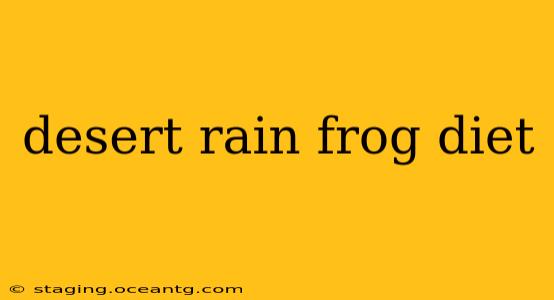The desert rain frog, Breviceps macrops, is a captivating creature known for its plump, round body and adorable appearance. But beyond its cute exterior lies a fascinating diet. Understanding what this unique amphibian eats is crucial to appreciating its ecological role and the conservation efforts needed to protect it. This comprehensive guide delves into the desert rain frog's diet, answering common questions and providing valuable insights into its feeding habits.
What do desert rain frogs eat?
Desert rain frogs are carnivorous, meaning their diet primarily consists of insects and other invertebrates. Their primary food sources typically include:
- Ants: These tiny insects make up a significant portion of their diet.
- Termites: Similar to ants, termites are readily available and a vital part of their food intake.
- Beetles: Various beetle species, both larvae and adults, are also consumed.
- Other invertebrates: This broad category includes spiders, crickets, and other small, ground-dwelling creatures that they can successfully capture.
Their diet is highly dependent on the availability of prey in their immediate environment. They are ambush predators, meaning they lie in wait, patiently camouflaged within the sandy substrate, until unsuspecting prey comes within striking distance.
How do desert rain frogs hunt?
Desert rain frogs employ a simple yet effective hunting strategy. Their plump bodies and sandy coloration provide excellent camouflage, allowing them to blend seamlessly with their surroundings. They remain largely motionless until prey wanders close enough. Then, with a sudden burst of speed, they snatch their meal with their sticky tongues. Their powerful jaws quickly secure the prey, ensuring a successful hunt.
What are the feeding habits of desert rain frogs?
While not highly mobile, desert rain frogs are opportunistic feeders. This means they consume whatever prey items are readily available and accessible. Their feeding frequency depends on the abundance of prey. During periods of plentiful food, they may feed more frequently, while scarcity dictates a less frequent feeding schedule. Their relatively slow metabolism helps them survive periods of food shortage.
Do desert rain frogs eat plants?
No, desert rain frogs are strictly carnivorous and do not consume plants. Their digestive system is adapted for processing insects and other invertebrates, not plant material.
What are the threats to their food supply?
Several factors can threaten the desert rain frog's food supply. These include:
- Habitat loss and degradation: Destruction of their natural habitat directly impacts the availability of their prey.
- Climate change: Shifting weather patterns can affect insect populations, leading to food scarcity.
- Pesticide use: Agricultural pesticides can contaminate their prey, impacting their health and survival.
How can I help protect desert rain frogs and their food sources?
Supporting conservation efforts focused on preserving their habitat is crucial. This includes:
- Supporting organizations: Many organizations work to protect the unique ecosystems where desert rain frogs live.
- Reducing pesticide use: Minimizing the use of harmful chemicals helps maintain a healthy insect population.
- Promoting sustainable land management: Responsible land use practices help conserve their habitat and the food sources within it.
The desert rain frog's diet may seem simple at first glance, but understanding its intricacies reveals a fascinating story of adaptation and survival within its challenging environment. By appreciating their delicate ecological role and the threats they face, we can work together to protect these remarkable amphibians and their precious habitat.
